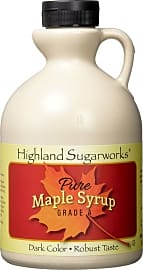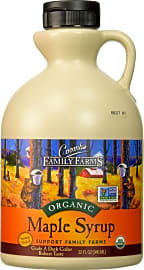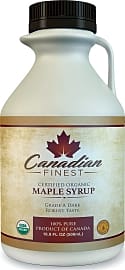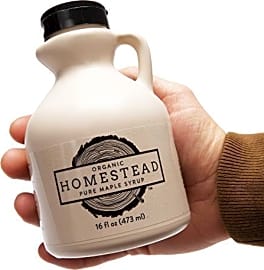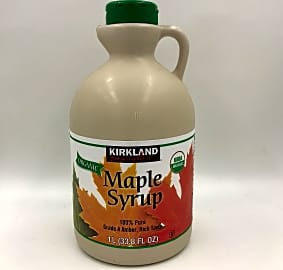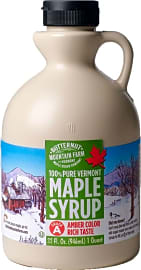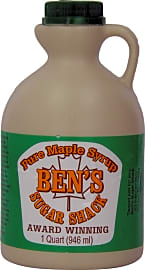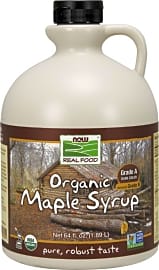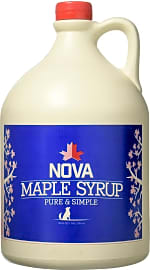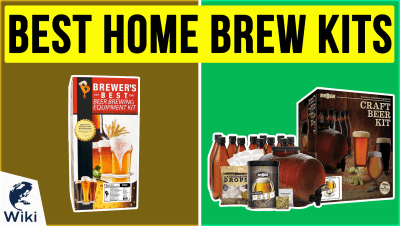The 10 Best Pure Maple Syrups

This wiki has been updated 38 times since it was first published in January of 2017. If you're tired of store-bought maple syrups that are filled with artificial ingredients, you should try one of these wholesome alternatives. Distilled from the sap of trees in New England, the Midwest, and Canada, they deliver a rich taste and boast antioxidants, minerals, and numerous health benefits. Up your morning pancake and waffle game using one of these all-natural choices. When users buy our independently chosen editorial selections, we may earn commissions to help fund the Wiki.
Editor's Notes
March 07, 2019:
We know some families go through a tremendous amount of maple syrup and will appreciate that the Nova Maple Pure & Simple comes in a gallon-sized jug, and the Ben's Sugar Shack Award Winning Dark Amber comes in a one-quart or two-quart option. The sweet stuff is good for more than just pancakes though. Those hoping to experiment with it in savory recipes, drinks, and more, will like Butternut Mountain Farm Amber Rich and Escuminac Unblended, both of which have unique flavor profiles that lend themselves to a variety of foods. Escuminac Unblended is also a great choice for those maple syrup elitists looking for that super pure, fresh-from-the-tree flavor, as is Canadian Finest Certified. Parents trying to get their kids off the artificial stuff will love Homestead Maple Robust and Kirkland Signature Grade A Organic. It's still sticky and sweet enough for the likes of picky kiddos.
Why Choose Pure Maple Syrup
Many producers tend to be family-owned and operated and take great care to keep their trees healthy by not over-tapping them.
Growing up, I used Mrs. Butterworth’s to fill every square of my Eggo waffles and utterly drown my pancakes with religious zeal. My young taste buds never noticed a lack of complexity in the warm, sticky sauce that poured out of those lady-shaped bottles — they were simply thrilled to experience something sweet. It would be many years before I realized I wasn’t actually ingesting true maple syrup. I was eating table syrup, which is a far cry from the genuine stuff.
If you take a look at the back of a bottle of Aunt Jemima, Log Cabin, or my coveted Mrs. Butterworth’s, you’ll notice a litany of ingredients. These products consist of corn syrup, are full of preservatives and emulsifiers, and are artificially flavored and colored. On the other hand, pure maple syrup is simply maple tree sap that has been boiled to create a thick, concentrated solution with nothing else added. This makes it ideal for families that want to avoid chemicals and additives.
It also retains plenty of its natural vitamins and minerals — you’ll find everything from calcium and iron to vitamins B6 and C. Of course, syrup is by no means a health food, but it can serve as an excellent substitution for processed sugar in baking, a light topping for ice cream, and a sweetener in your morning coffee. On top of all that, it tends to have a lower calorie count than honey.
Taste is another element to consider when choosing your syrup. They run the gamut from golden and amber to dark and very dark, and each type boasts its own complexities and flavor notes. For example, golden and amber varieties tend to have a buttery essence and are excellent drizzled over foods, whereas darker selections are ideal for baking or adding an earthy sweetness to home-brewed beer.
Depending on the company you purchase from, the manufacture of pure maple syrup can be better for the environment than that of its mass-produced cousins. Many producers tend to be family-owned and operated and take great care to keep their trees healthy by not over-tapping them. Plenty are also certified organic and therefore never use pesticides. In Canada, where sugarmakers account for about 70 percent of global syrup production, there are laws in place to protect forests from being cut down. These thriving woodlands promote better air quality and provide a home for all sorts of plants, critters, and micro-organisms.
How Pure Maple Syrup Is Made
Sugarmakers produce maple syrup much the same way they did hundreds of years ago. While modern manufacturers have access to technology in the vein of reverse osmosis filters and elaborate tubing systems, the principles behind production remain relatively unchanged. It happens in three steps: the tapping of the tree, the sugaring process, and bottling.
Once it has reached the proper consistency, it's filtered and graded before being packed into bottles and shipped out.
The three most popular trees used to collect sap are the sugar maple, the red maple, and the black maple. During the summer months, their leaves produce simple sugar through photosynthesis. As temperatures drop, the sugar makes its way down the trunk, where it's stored in the roots as starch. Around March, warmer conditions encourage the starch to convert back into sugar, and in the process, the tree pulls groundwater into the mix. This results in sweet, clear sap.
To access it, the sugarmaker will drill a small hole into the trunk. He'll then either place a spile into it or hook it up to a vacuum tube. If the drip method is used, he'll place a bucket beneath the spout to catch the liquid as it comes out. This process takes place around March and April, when temperatures consistently reach freezing at night and around 45 degrees during the day, a pattern that helps to coax the sap out easily.
Because the sap from a sugar maple consists of about 98 percent water, it requires dozens of gallons in order to produce just one gallon of concentrated syrup. To do this, the sap is boiled until most of the water evaporates, leaving behind a thick concentrate. Once it has reached the proper consistency, it's filtered and graded before being packed into bottles and shipped out.
A Brief History Of Maple Syrup
Maple syrup originated in North America hundreds of years ago. How the Native Americans who roamed modern-day Canada and the upper eastern portions of the United States discovered they could boil sap and reduce it to syrup remains unknown. It was most likely a happy accident, and there are multiple legends that attribute what may have happened to different tribes. What we do know for certain is that indigenous people had it all figured out by the time the Europeans came colonizing.
As demand continues to increase due to evolving consumer tastes, it's safe to say the industry will continue to thrive.
Indigenous methods for harvesting sap included making a V-shaped cut in tree bark and placing a wedge at the bottom. A basket would be left underneath to collect the dripping liquid over the course of a few days. Early Europeans mimicked this general process but instead used augers to drill holes that would accommodate wooden spouts. These settlers would then haul the collected sap back to camp for boiling. To make life easier, they eventually built small cabins known as sugar shacks to serve as more convenient, on-site production facilities.
This continued throughout the 17th and 18th centuries, as maple sugar was in demand as a substitute for expensive imported sweeteners. After the 1850s, cane sugar became readily available and thus immensely popular. In response to this new trend, manufacturers began concentrating on marketing maple syrup over its other forms.
Over the years, producers innovated new ways to streamline what was a very labor-intensive process. Evaporators and tractors helped to speed things up, and eventually, reverse osmosis machines and elaborate tubing systems that use vacuum pumps came on the scene.
Pure maple syrup has become an integral part of North American culture. Since its inception, it has developed into an extremely versatile food that's consumed all over the world. As demand continues to increase due to evolving consumer tastes, it's safe to say the industry will continue to thrive.


